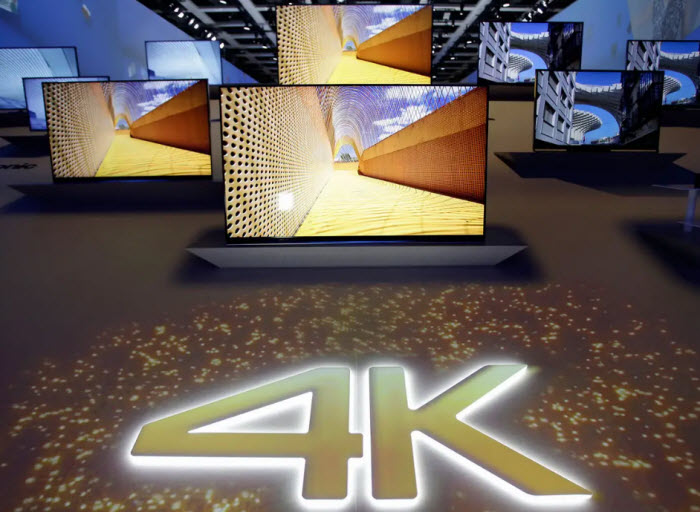Why Is 4K TV Not Showing 4K and How to Play 4K without Error?
With 4K becoming the standard for resolution, a growing number of people are making the jump to 4K TV. However, just because you have such a cutting-edge set doesn't mean that you can take full advantages of its 2160p resolution display. Many people encounter the 4K TV not showing 4K error. Type questions include "Why doesn't my 4K TV look 4K?", "Why is my 4K TV only showing 4K but 1080p?". If you've ever faced the same issue, follow the post, find the exact reasons and learn how to get 4K on Amazon Fire TV, Samsung TV, or Apple TV.

Table of Content
Part 1. Why Is My 4K TV Not Showing 4K?
Actually, to view 4K content on 4K UHD TV successfully, you will need a 4K TV, a true 4K content, 4K-capable streaming device, 4K UHD blu-ray player, 4K-compatible HDMI cable, and available internet connection. If your 4K TV doesn't display 4K content successfully or your 4K look weird on the TV, here may be some reasons.
- You may watch a lower-resolution video on your 4K TV. Ensure you are watching the content that is in 4K resolution.
- The video playback configuration isn't set up properly. Ensure the settings either on your 4K TV or the source device can output 4K.
- The HDMI cable or port may be outdated and doesn't support 4k video input. It should be labeled as High-Speed or HDMI 2.0.
- Your streaming device is not up-to-date and isn't 4k-ready.
- It might be a faulty hardware that doesn't support 4K resolution.
Part 2. How to Get 4K TV to Play in 4K without Error?
If you want the best out of the new 4K TV, here are some feasible solutions to avoid crucial 4K TV not showing 4K mistakes.
Solution 1. Choose the right HDMI port.
Not all HDMI ports are created equally. There might be HDMI 1.4, 2.0 and 2.1 ports on your TV. If you are using HDMI 1.4, your Amazon Fire TV/Samsung/Apple TV may show 1080p not 4k. To stream 4K content on your 4K TV, make sure the port, cable, and source are compliant with a protocol called HDCP 2.2. If your 4K TV not showing 4K, it is possible you are plugging into an incompatible port. In this circumstance, please try another port or check which port you should use for your 4K video by checking the manual on your 4k TV. A regular HDMI 2.0 capable can handle 4K 60hz, while an HDMI 2.1 cable can handle 4K 120hz. Make sure your TV has an HDMI 2.1 port.
Solution 2. Make sure your source content is 4K.
4K TVs are capable of playing stunning contents, however, this depends on the quality of the source content. In fact, the majority of free-to-air channels are broadcast in standard 576i, or high definition 1080i, compared to the 3840p resolution in a 4k TV. That is the reason why your 4K TV doesn't show a 4K picture.
If you cannot take advantages of the 4K content that is available, you can also take advantages of the 4K TV's upscaling feature. Generally, it stretches or scales the image to fill its native 4k resolution in such a way to producing excellent picture quality during the playback. The results via upscaling can look better than what you see on a 1080p TV. And the standard or HD resolution content will be as much closer as 4K.
The process of scaling just lets the source content fill the screen and produce excellent picture, which however, doesn't improve the quality of source content, since the data or information is not there to tell the TV what to display. Typically, VHS, standard resolution broadcast, or standard DVD, some low-quality 720p/1080p video won't look great on the 4K TV even after upscaling.
In this circumstance, you can upscale video to 4k content with a video upscaler software first. Winxvideo AI is an AI-based 4K video converter that is able to upscale video from 720p/1080p to 4k 2160p with detailed data and information. Therefore, the quality of the final video is drastically enhanced.
Related post: how to upconvert 1080p to 4k for high quality >>
Solution 3. Be sure the internet connection is ready for the onslaught of data.
On the other hand, not all 4K content on the 4K TV are available in 4K. Streaming 4k content taxes internet connections hard since 4K file size are 4x larger than files in 1080p HD. Typically, Netflix and Display+ recommend at least 25Mbps for 4k streaming while Hulu requires a lighter 13Mbps connection. If your content is available in 4K resolution and the internet connection can handle the data, the 4K TV will automatically stream the video in 4K. But if the internet connection is congested, the 4K video will buffer and resolution may drop automatically.
An internet connection speed of 15-25mbps is required for a smooth 4k playback.
Solution 4. Pick the right settings.
To get the 4K picture looking good on the 4K TV, it’s time to set the settings. Try avoiding Display or Vibrate mode in your TV's menu. Instead, choose cinematic, movie, or calibrated mode.
In the meantime, make sure all the cable ends are connected properly at both ends of the source device and the 4K TV. Be sure the right end of cable is plugged into the device and the 4K TV.
Additionally, if you want your 4K TV to show 4K HDR in order to get the expanded colors and contrast, just select the mode, or its variation like HDR10, Dolby Vision, etc. You can also turn off motion smoothing in a bit to cut down the response time in the game mode. This is especially good during gaming but don't keep it on all the whole day.
To get the best picture settings for 4K TV, please click here >>
Solution 5. Make sure to have a proper screen size and seating distance.
It is unnoticeable to perceive any visual difference between 1080p and 4K on many 4K TV with 65-inch or below screen size. However, the difference may be noticeable if the screen size is larger than 65 inches. If you have the budget and room, make sure to get a 4K TV with a screen size larger than 65 inches.
On the other hand, seating distance also makes difference. Since the pixels are much smaller, the viewing experience will be satisfied if you sit closer to a 55 or 65-inch 4K TV than a previous HDTV of the same screen size. To be another word, the seating distance to a 4K TV is much closer than that with a 1080p HDTV.
Solution 6. Make sure the streaming device is 4k ready.
If the streaming device doesn't make the grade, your 4K TV will not show 4K content consequently. Generally, Roku Ultra, Chromecast w/Google TV, Amazon Fire TV, Apple TV 4K, NVIDIA SHIELD TV Pro are capable of handling 4K content. Roku Ultra is regularly priced at $90-95 but frequently less than $70, which is affordable for most users. If you are a gamer, you can also opt for the NVIDIA SHIELD TV PRO priced at $199.99 for streaming 4k video games.
Solution 7. Select a 4K TV that incorporate HEVC or AV1 codec decoder.
It is the new norm to stream in 4K. But it's no easy task to play that 4K video on 4K TV, especially when your set isn't ready for its codec – HEVC or AV1, a relatively complex codec is used to compress the large 4K video to a relatively acceptable file size for easier storing and transmitting. Since more complicated algorithms are used to reduce the file size of the 4K video, such codec cannot be played on many devices including the 4K TV, if without the relative decoder. Consequently, your 4K TV won't show 4K, instead, you may get black screen with audio only.
In this circumstance, you can choose a 4K video converter that can change video codec from HEVC or AV1 to a more compatible codec like H.264 and then play the 4K video on your TV set.
Other suggestions
- 4k is available from both Direct TV and Dish network.
- Make sure the cable, satellite, or streaming service provider supports 4k.
- The 4k blu-ray disc format is available. Make sure you have a 4K UHD Blu-ray player.
Conclusion
In this post, we've listed all the possible solutions to fix the 4K TV not showing 4K issue. Just apply the fixes and let us know which solution worked for you.
FAQ about 4K TV
1. How do I know if my TV is playing in 4K?
To check if your TV is able to show 4K, you can go to your source’s Display or Video settings menu,and then look at the output resolution. Additionally, you can also press the Info button on your TV's remote control, through which you can get an on-screen display that shows what resolution the TV is receiving.




















